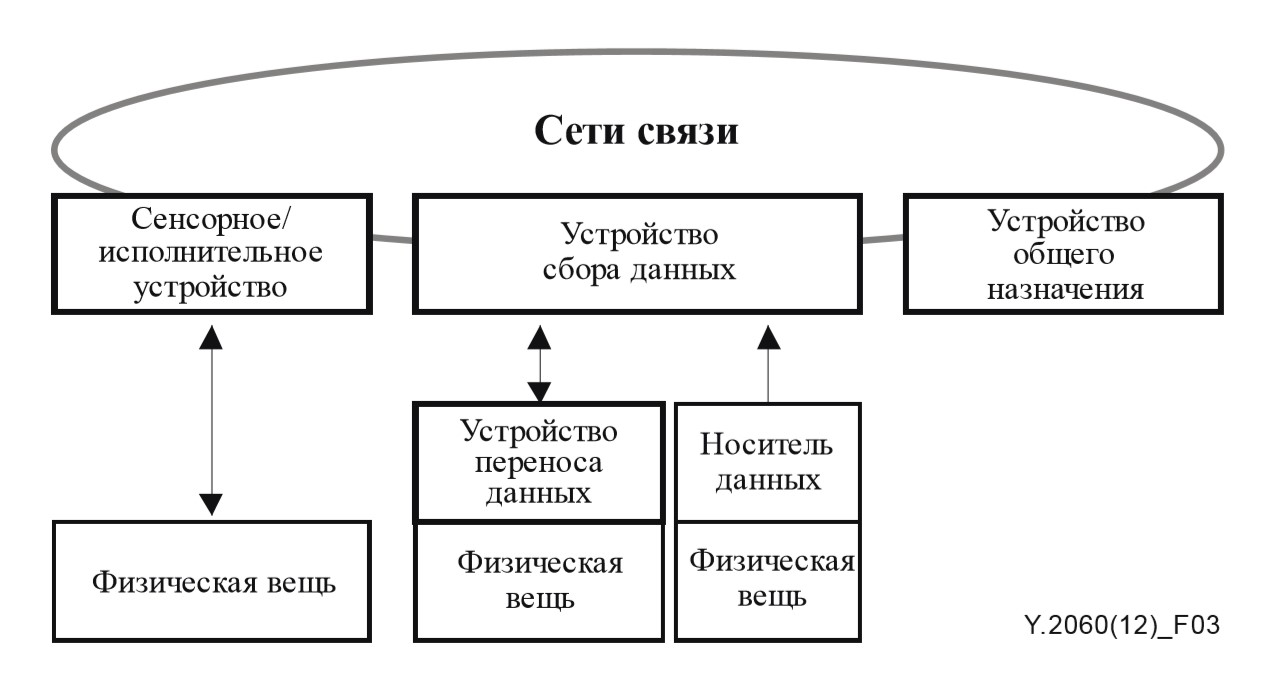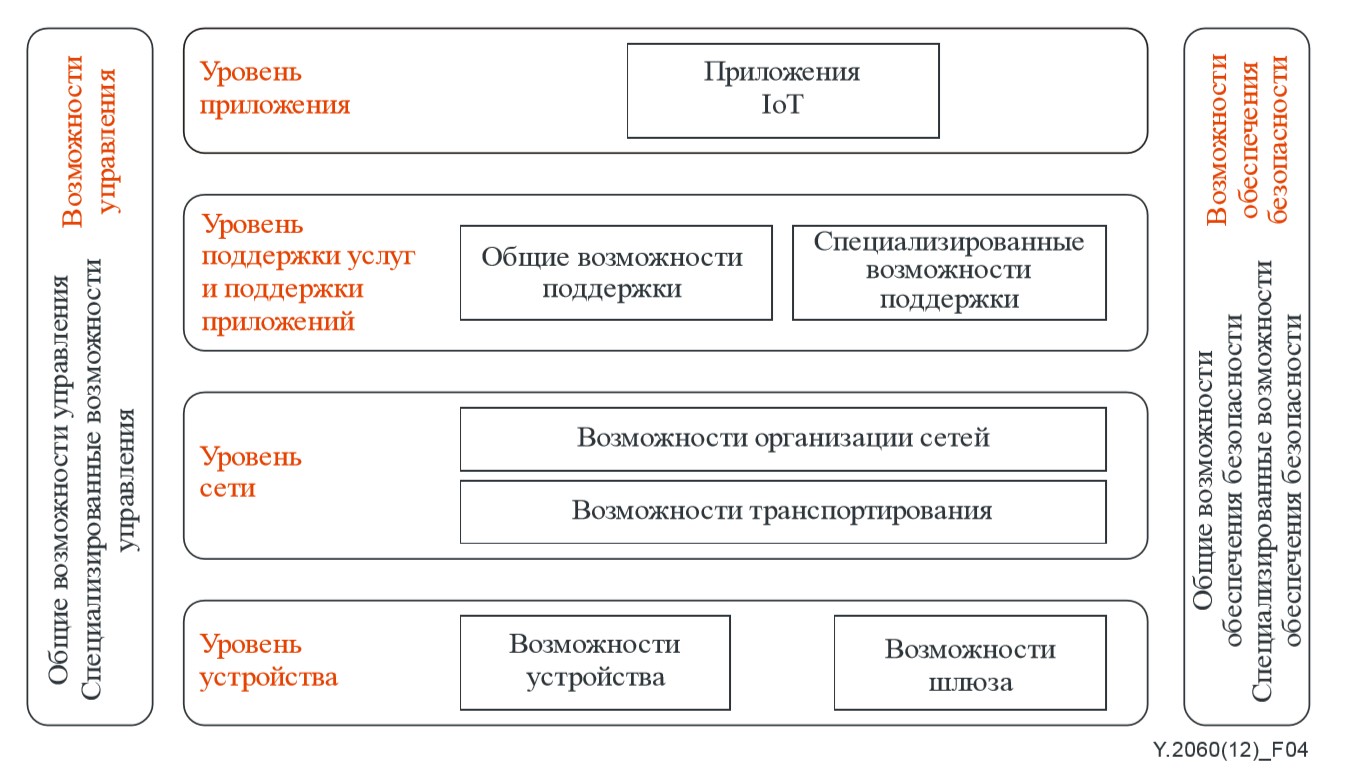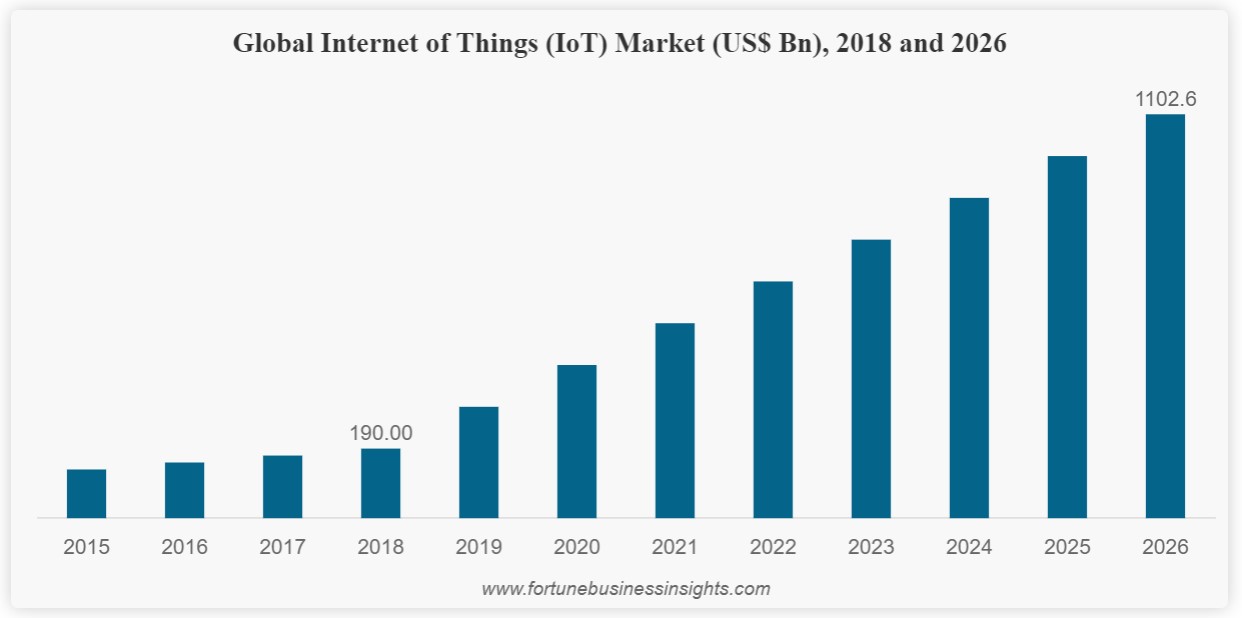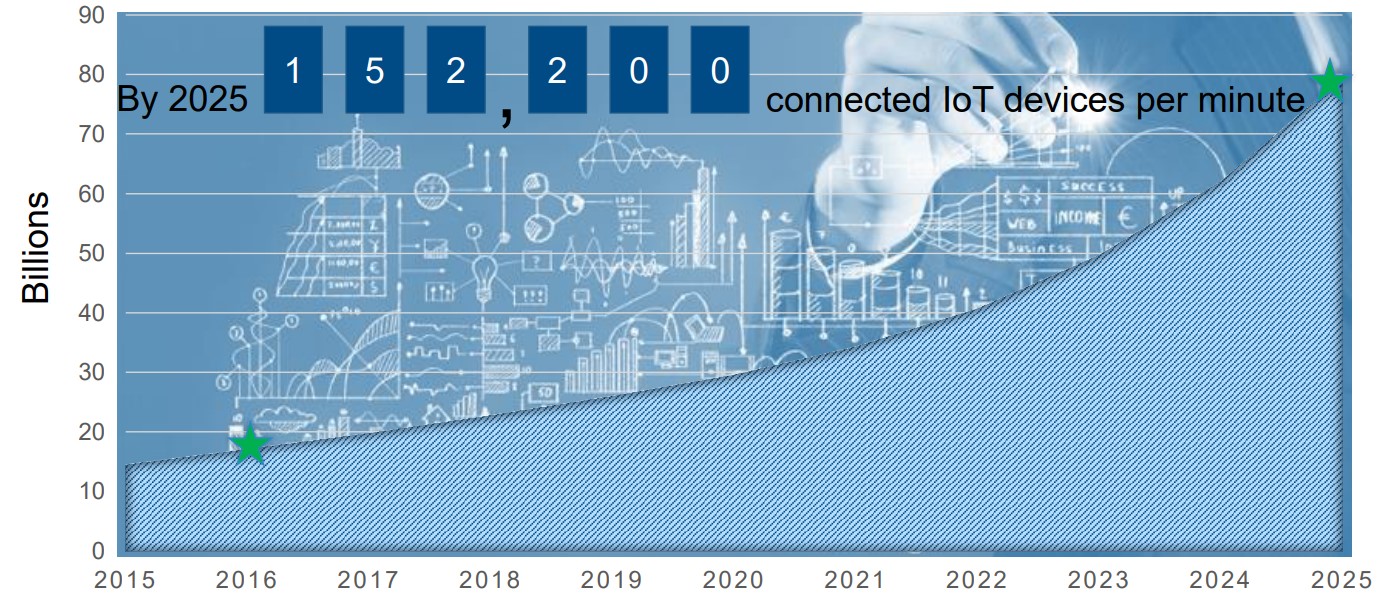
About IoT today say almost from every ("smart") iron. Moreover, in such conversations, basic things are usually missed: what is the Internet of things, what does it consist of, and who can answer these questions as “authorized bodies”. Meanwhile, these issues are very relevant. So, let's say, your (talking about IoT) “smart” iron - does it belong to the Internet of things? In this post, we will talk about the architecture of the Internet of things: what components it consists of, which technologies are of particular importance, which solutions can simplify mass deployment, and who is in charge of IoT in the world.
What is the internet of things?
The research company Gartner defines IoT as a network of physical objects containing means for interacting with the external environment and between themselves, as well as for transmitting information about their condition and receiving commands.
A less abstract definition is suggested by McKinsey : IoTs are sensors and drives embedded in physical devices and connected to the Internet via wired or wireless networks.
Not only device manufacturers, but also specialized organizations are involved in the development of IoT, including the International Telecommunication Union (ITU), Industrial Internet Consortium and IETF.
In the recommendations of the Y.2060 of the International Telecommunication Union , called Overview of the Internet of Things , the Internet of Things appears as “a global infrastructure that provides sophisticated services by connecting physical and virtual things based on existing and developing interoperable information and communication technologies.” A thing in this definition means an object of the physical or virtual world that can be identified and connected to communication networks. A device in the context of IoT is a piece of equipment that has the necessary communication capabilities and can measure, operate under certain conditions, enter, store and process data.

Types of IoT devices and their interaction. Source: ITU-T Y.4000 / Y2060
As recommended by the Telecommunication Standardization Sector of the International Telecommunication Union (ITU-T), IoT is a network of devices that are closely related to things. Touch and actuators interact with physical things in the environment. Data collection devices read information from physical things or write it to physical things, interacting with data transfer devices or data carriers connected or connected to a physical object.
In other words, IoT is:
Physical / Virtual Objects
+
controllers / sensors / actuators
+
the Internet
Thus, a physical instance of an IoT element is an object that
- intelligent: has a microcontroller and software for control;
- can inform or act: contains a sensor for measuring any physical parameters or an actuator whose operation can be controlled;
- available over the network.
The Y.2060 recommendations also contain an IoT reference model that serves as the basis for standardization. The reference architecture gives developers an understanding of what features are needed in IoT and how they interact.

IoT reference model. Source: ITU-T Y.4000 / Y2060
IoT architecture is also being developed by the IoT World Forum (IWF). This is an annual event in which representatives of business, states and academia participate. The IWF Architecture Committee published its version of the IoT Reference Model in 2014. It well complements the option proposed by ITU-T, since the IWF pays attention not only to the levels of devices and the gateway, but also to the upper levels, which are more important for application development, middleware and support for the industrial Internet of things.

IoT reference model according to IWF. Source: Cisco
What are the key elements of IoT?
The first is protocols. Internet standard protocols either turn out to be redundant for IoT, or do not provide the necessary characteristics for cases where a short response time and high network reliability are required. In addition, IoT device processors typically have low performance to keep power consumption low. This requires the development of network protocols specifically tailored for use on the Internet of things.
Several working groups within the IETF and W3C are involved in this. For example, the adaptation of IPv6 for host networks with limited resources is handled by the 6lo working group. This group inherited the development of the 6LoWPAN group, which developed methods for compressing packet headers and optimizing neighbor discovery. The 6lo group is focused on a wider range of protocols: Bluetooth Low Energy, ITU-T G.9959, DECT Ultra Low Energy, as well as the MS / TP protocol for RS-485 networks.
The list of other IETF IoT working groups and what they do looks like this:
- DICE - DTLS In Constrained Environments - TLS / DTLS profile suitable for devices with limited resources;
- ACE - Authentication and Authorization for Constrained Environments - (RFC
- 7744) - authentication mechanisms for accessing resources in restricted environments;
- COSE - CBOR Object Signing and Encryption - Simplified CBOR Analogs
- for signing and encryption methods;
- 6TiSCH - IPv6 Over the TSCH Mode of IEEE 802.15.4e — IPv6 implementation for Time-Slotted Channel Hopping;
- LWIG - Lightweight Implementation Guidance (RFC 7228) - general terminology for networks with limited nodes (CoAP and IKEv2);
- ICNRG - Information-Centric Networking - Applicability of technologies for IoT scenarios;
- CFRG - Crypto Forum — Fundamental encryption methods suitable for IoT.
No less important technology for IoT is the fifth generation communications. Implementing many IoT use cases requires upgrading data networks to 5G. Fifth-generation networks can reduce latency and can adapt to applications involving multiple connections, help reduce power consumption and get a huge mobile data transfer rate: over 10 Gb / s. In this case, the signal delay in 5G is reduced to 1 ms. For comparison, in 4G the delay is 10 ms, and in 3G - 100 ms.
Sensors are at the bottom of the technology stack that make up the IoT reference model. They provide the interaction of the physical and virtual world, collecting analog data and converting them into digital form. To transmit the collected information, the sensors connect to the network and communicate with servers and gateways using the Bluetooth, NFC, RF, Wi-Fi, LoRaWAN and NB-IoT protocols.

Different types of sensors. Source: CircuitDigest
The sensors themselves only record the physical quantity and convert the measured value into a digital format for sending to the microcontroller, which is the “smart” part of the sensor.

Toshiba 32C100U2 IR Sensor Board Infrared Sensor
The development of technology makes sensors very compact. For example, the 14-bit BHA250 acceleration sensor manufactured by Bosch Sensortec has dimensions 2.2 × 2.1 × 0.95 mm, but it also contains a 32-bit microcontroller.
Finally, IoT platforms play a crucial role. According to the McKinsey report, about 40% of the economic value of IoT is related to compatibility, that is, how devices can interact with each other. To reveal all the advantages of the Internet of things, not only fast communication channels and cost-effective protocols are needed, but also the standardization of all levels of IoT functioning in accordance with reference models.
IoT platforms partially alleviate the severity of this problem, but there is no unity among them. As of mid-2017, IoT Analytics has counted 450 companies offering their IoT platforms. This number is less than the list of IoT devices manufactured in the world, but more than enough to create compatibility issues.
What are IoT platforms and why are they needed?
In short, these are solutions that provide a unified interface between IoT end devices and data processing services. And to explain why they are important, we will start from afar.
A Cisco study found that 75% of IoT-related projects fail. More than 1800 company executives and IT leaders took part in the survey, the purpose of the survey was to identify the main barriers that restrict the implementation of the Internet of things in enterprises. According to the findings of the study, the main obstacles for organizations wishing to implement IoT are the costs and timing of projects. Another stop factor was the limited expert knowledge of staff members.
These problems can be eliminated by the use of solutions that provide a unified interaction between IoT end devices and data processing services, the very same IoT platforms.
Let us explain: if the company already has a fleet of equipment, when implementing IoT, it will be necessary to connect it to the new infrastructure. At the same time, some of the "old" devices can quite successfully fulfill their production functions, but not be able to connect to the Internet. Replacing such equipment with IoT-compatible will incur large costs. This will increase the payback period, since you will have to write off fully functional machines and assemblies.
But even if the equipment is compatible with IoT, the question remains as to what data needs to be collected and used, how to conduct an in-depth analysis of the collected information and provide prompt feedback. IoT platforms just provide seamless integration of hardware using various types of connections, data transfer to connected devices or between them.
IoT platforms are offered by many high-tech and IT companies. Toshiba’s development for integrating IoT devices and services is called SPINEX. In developing the SPINEX IoT platform, Toshiba’s extensive experience was used in energy, the production of semiconductor components, as well as in the field of the Internet of things, artificial intelligence, voice and video recognition (that is, in all that we regularly talk about at Habr).

SPINEX platform. Source: Toshiba
SPINEX provides a single space for collecting data from connected equipment, devices and products, storage, visualization and analysis of collected data. Through the use of an open architecture, SPINEX can interact with various cloud providers and devices. The platform gives users three key technologies:
- peripheral computing: to minimize network latency and perform complex data processing, SPINEX divides the process into two parts: basic operations are performed in real time on edge devices, and powerful servers in the cloud infrastructure perform advanced analysis;
- digital doubles: SPINEX uses artificial intelligence to build digital models of real objects, which allows you to more effectively monitor changes in the environment and transmit the necessary commands to devices;
- media analytics: Toshiba’s media analysis technology is used to accurately identify voice and images.
In 2016, Toshiba launched the SPINEX-based cloud service IoT Standard Pack. The service is a unified solution for many tasks related to the Internet of things. It allows you to quickly deploy an IoT network in the enterprise by using templates to collect data and quickly connect devices to the IoT infrastructure using plug-n-play technology.
How relevant is all this and where is the IoT market heading?
Sometimes it seems that the brave world of the Internet of things is nothing more than a fantastic picture. This is not true. A Fortune Business Insights report indicates that the global Internet of Things market, valued at $ 190 billion in 2018, will reach $ 1.11 trillion by 2026, showing a combined growth rate of 24.7% per year.

IoT Market Prediction 2018-2026. Source: Fortune Business Insights
The largest market segment is expected to be the banking sector and the financial services sector.
Gartner analysts report that in 2019 the number of IoT devices reached 14.2 billion. The company also predicts that by 2025 the number of connected devices will reach 25 billion.

IDC forecast for IoT connectivity growth
IDCs provide an even more optimistic forecast : by 2025, 152,200 devices will be connected to the Internet of Things Internet every minute. Multiplying 152,200 by 525,600 (the number of minutes per year), we get that in 2025 the Internet of Things will contain about 80 billion devices.
According to an IoT study, The Internet of Transformation 2018, published by Juniper Research, North America, Western Europe, the Far East and China remain key IoT markets. These regions will provide more than 60% of all income related to the Internet of things.